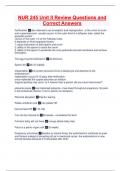NUR 245 Unit II Review Questions and
Correct Answers
Fertilization ✅also referred to as conception and impregnation.. is the union of ovum
and a spermatozoon, usually occurs: in the outer third of a fallopian tube, called the
ampullar portion.
Occurs in the outer 1/3 of the Fallopian tube.
It depends on three separate factors:
1: equal maturation of both sperm and ovum
2: ability of the sperm to reach the ovum
3: ability of the sperm to penetrate the zona pellucida and cell membrane and achieve
fertilization
The egg must be fertilized in ✅24-48,hours
Sperm life ✅48-72 viability
Implantation ✅the zyote's structure forms a blastocyst and attaches to the
endometrium;
implantation occurs 8-10 days after fertilization
once implanted the zygote becomes an embryo
Vaginal spotting may occur "is it heavier than a period, did you have intercourse?"
placenta previa ✅low implanted placenta---may bleed throughout pregnancy. No pain,
it will sometimes resolve, if not C-section is necessary
Placenta abruption ✅Painful, tearing
Palate umbilical cord ✅Can palate HR
Normal fetal HR ✅110-160
You can be induced at ✅39 weeks-- considered full term
Full term baby will not have ✅Lanugo (black baby hair)
Fetus is a pelvic organ until ✅20 weeks
Pregnancy structures ✅decidua or uterine lining: the endometrium continues to grow
and thicken instead of sloughing off as in menstrual cycles. the endometrium is now
termed decidua because it is discarded after birth.
, chorionic villi: 11th or 12th day after fertilization, miniature villi, resembling probing
fingers reach out from the trophoblast cells into the the uterine endometrium to begin
formation of the placenta.
Placenta: circulation, endocrine function (hCG, progesterone, estrogen, hPL), placental
proteins (decreasing immunologic impact of the growing placenta and help prevent HTN
of pregnancy)
Amniotic membranes: chorionic membrane (outermost membrane) amniotic membrane
(forms beneath the chorion. no nerve supply, neither mother or child have pain when
they rupture.
Amniotic fluid:continually being newly formed and absorbed by direct contact with the
fetal surface of the placenta. The major method of absorption happens within the fetus,
continually swallowing the fluid, absorbed from the fetal intestine into their blood stream,
to the umbilical arteries and to the placenta and is exchanges across the placenta to the
mothers blood stream.
Umbilical cord:provides a circulatory pathway that connects the embryo to the chorionic
villi of the placenta. Transport oxygen and nutrients to the fetus from the placenta and
returns waste from the fetus to the placenta.
Growth of Fetus ✅end of fourth gestational week: length of the embryo is 0.75cm,
weight is 400 mg, spinal cord is formed and fused at the midpoint, head is large in
proportion and represents one third of the entire structure, rudimentary heart a[pears a
a prominent bulge on the anterior surface, arms and legs are bud like, rudimentary
eyes, ears and nose are discernible.
End of eight gestational week: length is 2.5cm, weight is 20g, organogenesis is
complete, heart with a septum and valves, beats rhythmically, facial features are
definitely discernible, arms and legs have developed, external genitalia are forming but
sex is not yet distinguishable, abdomen bulges forward because the fetal intestine is
growing rapidly, sonogram sows gestational sac, which is diagnostic of pregnancy.
End of 12th gestational week (first trimester): length is 7-8cm, weight 45 g, nail beds are
forming on fingers and toes, spontaneous movements are possible, they are usually
faint to be felt by mother, some reflexes, Babinski reflex, bone ossification centers form,
tooth buds are present, sex is distinguishable on toward appearance, urine secretion
begins but may not be evident in amniotic fluid, heartbeat is audible through Doppler
technology.
End of 16th week: length 10-17 cm, 55-120 g, fetal heart sounds are audible by an
ordinary stethoscope, lanugo is well formed, both liver and pancreas are functioning,
fetus actively swallows amniotic fluid , demonstrating intact but uncoordinated
swallowing reflex, urine is present in amniotic fluid, sex can be determined by
ultrasonography.
End of 20th gestational week: length of the fetus is 25cm, weight is 223g, spontaneous
fetal movements can be sensed by the mother, antibody production is possible, hair,
eyebrows form, vernix caseosa begin to cover skin, meconium is present in the upper
intestine, brown fat, t




